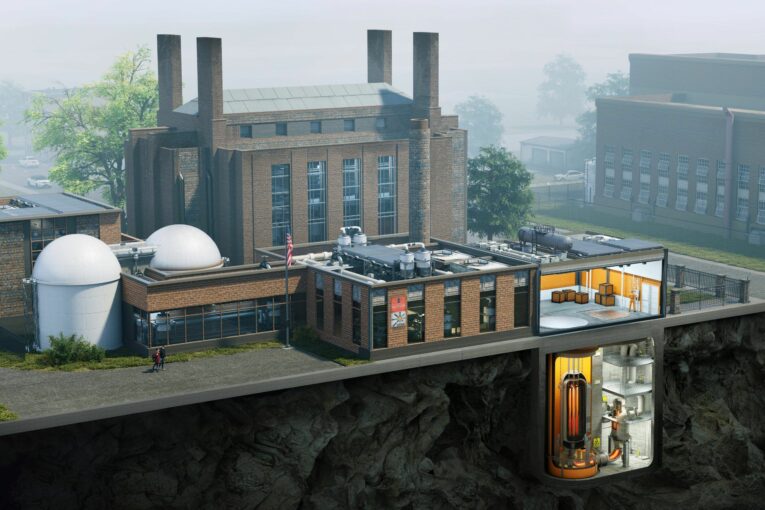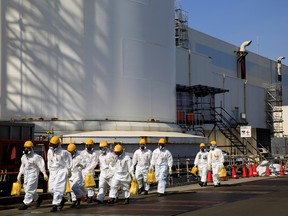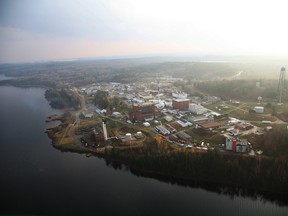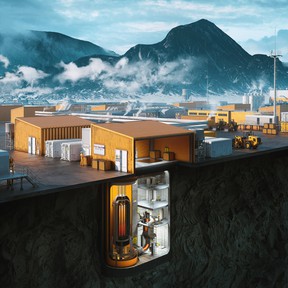
At the Ultra Safe Nuclear Corporation, a large part of Ken Darlington’s job involves convincing the public that the latest generation of nuclear technology is safe — so safe, in fact, that it can be mass produced.
The USNC-Power, as the U.S.-based company is known in Canada, is developing the smallest nuclear reactors around — designed to produce enough power to provide electricity for about 5,000 homes, or roughly five megawatts. If all goes according to Darlington’s plans, as vice president of corporate development in Canada, there could be around 100 reactors around the country in two decades.
That’s a huge jump: Canada has roughly 19 large reactors, each around 900 megawatts, at six plants. As efforts to reduce emissions gather momentum, Darlington and others are advocating for nuclear power as a less carbon-intensive alternative to fossil fuels. But the high cost of nuclear power, as well as the catastrophic safety record, as seen in the 2011 Fukushima disaster in Japan as well as the Chernobyl meltdown in 1986 and others, has stopped the industry’s expansion.
“I think it’s going to come down to the perception of the safety issue,” Darlington told the Financial Post. “That’s where a lot of the work needs to happen.”
It’s been about a decade since a tsunami off the coast of Japan triggered the Fukushima nuclear power plant meltdown — the latest in a string of nuclear disasters stretching back to Chernobyl in 1986 — which resulted in hydrogen-chemical explosions, the release of radiation, the evacuation of more than 140,000 people, and which is still being cleaned up.

There are also issues around nuclear waste: for more than a decade, Canada has been searching for a permanent underground repository where it can leave the radioactive waste, a byproduct of nuclear power generation, to decay — a process that is estimated to take hundreds of thousands of years. For now, nuclear waste remains stored nearby where it is produced.
Despite these issues, Darlington is helping lead an effort to revive nuclear power in Canada, through small modular reactors. The idea is to gain a licence for a design, and then deploy the model to outposts that are not connected to the electrical grid — to mines, oil projects and remote communities dependent on diesel.
“Anytime you have a new reactor design it needs to go through licensing,” Darlington said. “The whole idea is to have a consistent design, so you’re producing the same thing, every time.”
In 2020, his company’s Canadian subsidiary and Ontario Power Generation struck a joint venture to acquire Global First Power Limited, which aims to develop a micro modular nuclear reactor: it’s about the size of a tanker truck turned on its side, vertically, Darlington said.
It is planning to install a commercial demonstration project at Canadian Nuclear Laboratories’ Chalk River site, outside Ottawa, that will take up approximately two football fields, and consist of one plant that generates 15 megawatts of thermal heat, and an adjacent plant that converts the heat into five megawatts of electricity.
The Canadian Nuclear Safety Commission is currently reviewing a licence application for the reactor, and Canadian Nuclear Labs is conducting a process to site the micro modular reactor on its property. The power would be deployed into the grid.

Meanwhile, separately, Ontario Power Generation, announced a deal earlier this month, in which General Electric and Hitachi would build a small nuclear capable of generating enough power to produce 300 megawatts of electricity — at its Darlington plant.
Proponents such as Darlington say that small reactors rely on new technology that reduces the possibility of the runaway chain reactions and other failures that led to disasters in the past.
Nuclear fission works by splitting atoms through a process that generates enormous amounts of heat, which in turn is used generate electricity. For instance, the heat can create steam to power a turbine.

But containing the heat creates risks: in Japan, floods from the tsunami knocked out the emergency diesel generators that were powering the cooling process, which led to a meltdown of the reactor.
Darlington says Global First Power is safer than past nuclear projects of larger scale: it uses passive, cooling systems, which make runaway meltdowns impossible, he said. Plus, it uses small pellets as fuel, which Darlington said are safer than the rods used at larger reactors.
Also, it’s cheaper, he said, because the reactors are designed to be produced at scale, whereas in the past all nuclear projects have been one-of-a-kind, subject to cost overruns and construction delays. He projected a reactor would cost about $200 million.
There are many skeptics.
M.V. Ramana, a professor of public policy at the University of British Columbia’s School of Public Policy and Global Affairs, said nuclear power is inherently expensive, and past projects were designed to be larger in order to reduce costs by capturing economies of scale.
He also said past projects have tried to use passive cooling systems, but nuclear fission is inherently dangerous and it’s difficult to judge the safety of reactors that haven’t been licensed or produced yet.
“What we know about nuclear accidents is just about every one of them is unique in the way it happened,” said Ramana. “There are many ways of having an accident.”
For that reason, he said the risks outweigh the benefits: even if 100 small modular reactors were deployed, it would constitute just a small portion of the country’s electricity supply, but each reactor would generate radioactive waste and pose the threat of an accident.
What we know about nuclear accidents is just about every one of them is unique in the way it happened
M.V. Ramana
Neil Beveridge, an analyst at research firm Sanford C. Bernstein & Co, LLC, wrote that small modular nuclear reactors are attracting a lot of attention amid a flood of investment into decarbonization technology.
“While nuclear has many problems, including safety and cost competitiveness, the one big advantage is that it offers baseload clean energy supply, which is hard to replicate,” Beveridge wrote in a note to investors earlier this month.
Given the variable nature of wind and solar power, dependent on weather, there is growing interest in whether nuclear can be harnessed as a clean baseload power source, he wrote, adding that the promise of cost-competitiveness and safety remain untested.
Darlington said USNC was founded in 2011 by a family office in Seattle, and its technology spun out of U.S. National Laboratories. So far, he said, the company has raised $100 million from U.S., but the company’s investors and balance sheet remains private.
Given the history of nuclear disasters, in which radioactive material has leaked into the environment, he said persuading the public on the safety of new small modular reactors will be a critical factor in adoption. Still, Darlington declined to disclose information about his company’s founders or investors.
Similarly, Ontario Power Generation, structured as a corporation but owned by the province, declined to disclose the terms of its deal with USNC-Power to acquire Global First Power in 2020, including the price of the acquisition or other details about the proposed Chalk commercial demonstration reactor at the Chalk River Lab.
Robin Manley, vice president of new nuclear at OPG, said the aim is to use small modular nuclear reactors for industrial purposes, whether powering a remote mine and then maybe use the excess power generated during off-peak periods to produce hydrogen — another clean fuel.
But he acknowledged the technology remains a future option. Even at Chalk River, OPG is targeting 2026 as a start date for the 5 MW micro modular reactors, while the GE Hitachi small modular reactor, of around 300 MW capacity, will not be ready until 2028.
‘It’s going to be cost-competitive or cheaper than diesel,” he said, but added, “When you haven’t actually built a project yet, you don’t yet know the full cost.”
CORRECTION: An earlier version of this story said the Chernobyl nuclear disaster occurred in 1957. It occurred in 1986. We regret the error.
Financial Post
• Email: [email protected] | Twitter: GabeFriedz
_____________________________________________________________
If you liked this story, sign up for more in the FP Energy newsletter.
______________________________________________________________
You can read more of the news on source
